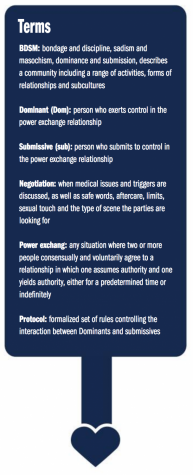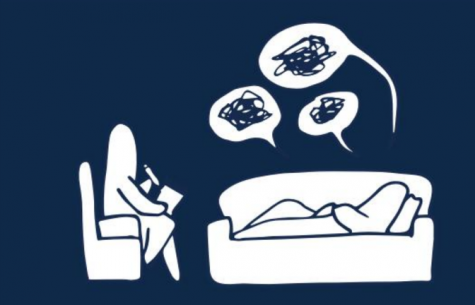Unshackling BDSM Myths
Art by Claire Osborn
 By day Evie Lupine (due to the sensitivity of this topic, Evie has asked to be identified by her public persona not her legal name) is a career woman in a field filled with men. By night she produces videos for her YouTube channel dedicated to people interested in BDSM. Her channel is focused on educating people of all ages and types about the BDSM lifestyle and sharing her personal journey.
By day Evie Lupine (due to the sensitivity of this topic, Evie has asked to be identified by her public persona not her legal name) is a career woman in a field filled with men. By night she produces videos for her YouTube channel dedicated to people interested in BDSM. Her channel is focused on educating people of all ages and types about the BDSM lifestyle and sharing her personal journey.
BDSM, which stands for bondage, domination, sadism and masochism, is a specific realm of sexual exploration that involves two consenting parties play-acting certain fantasies to indulge their sexual desires. While there are often contracts involved in many BDSM relationships, they aren’t legally binding. Rather the contracts help create the illusion of power as well as lay out the rules and limits of each party.
Lupine, 23, grew up in a military family. While in college, she became interested in the BDSM lifestyle and found there was a lot of missing information.
“The internet was dominated by 40 plus year old kinksters and information from 30 years ago,” she said. “When I started going to classes and dungeons I thought, ‘what the heck, I will start talking about my experiences too.’”
While many understand this world through fictional works like the trilogy Fifty Shades of Grey, there are nuances to BDSM that media tends leave out.
Lupine feels it’s nearly impossible to determine how anyone develops their BDSM preferences, but she feels hers came from a combination of growing up Catholic and observing her parents’ relationship.
“Seeing how my mother always served my father and the mutual love and respect they have always had,” Lupine said. “Service, repentance for sins, being meek and humble [were] all big messages I got as a kid and took with me as life values moving forward.”
Despite the feminist movement of the past few decades, women exploring their sexuality remains a sensitive topic in society. Women are often shamed for not only desiring sex, but also desiring a certain kind of sex. Feminism teaches women to be strong and in charge and many would argue choosing to submit in the bedroom is a reversal of feminist ideals.
Lupine considers herself a feminist, and she finds BDSM and feminism aren’t at odds with one another.
“I think the misunderstanding comes from the stereotype of BDSM just being submissive women giving up power to men,” she said. “But BDSM is a free choice – people choose to give up or obtain power from other people with clear negotiation and consent.”
To Lupine, BDSM can be a powerful way for a woman to take control over her sexuality by understanding what she wants and how to ask for it. Additionally, BDSM isn’t always about power.
“It can be just about having fun, about letting go of emotions, about de-stressing, about so many other things besides just subordination to another person,” she said. “And being able to have that and be okay with that is a revolutionary and subversive way of engaging in sexuality.”
In discovering one’s sexual desires, some choose to seek professional advice. Andrea Battiola is a Licensed Professional Counselor in Washington D.C. From a young age, Battiola knew she wanted to be a sex therapist.
“I always felt it was a conversation that wasn’t being had enough,” Battiola said. “I intuitively knew how important sex was in relationships and for individuals and was disturbed by the lack of conversation about it.”
Battiola works with a number of women in her practice and found that almost every one of them struggles with messages they’ve received about their sexuality throughout their lives.
“With 95 percent of the women I work with, we’re having conversations about messages they’ve received about their sexuality and relationships,” she said. “[We discuss] what messages do you want to keep and which ones do you want to get rid of or upgrade.”
Many messages women received throughout their lives leave them with feelings of guilt and shame, according to Battiola. To help women embrace their desires, Battiola gives them homework.

“On your own, explore your body through touch,” Battiola tells her clients. “Women having sexual problems usually are distracted by thoughts of shame or guilt.”
When it comes to specific desires, Battiola encourages her clients to explore whatever satisfies them, whether that be exploring fantasies with their partners or exploring BDSM or kink relationships.
“It isn’t my job to tell anyone that they shouldn’t want what they’re wanting sexually,” Battiola said. “I do a lot of reinforcing because there’s nothing shameful about having kink interests. [There’s] nothing wrong with that. We talk about it. We explore it.”
Dr. D.J. Williams, Ph.D. is a multidisciplinary social and behavioral sociologist who studies leisure science with the Center for Positive Sexuality. Though he began his career studying how leisure relates to crime and offender rehabilitation, while doing post-doctoral work, he came across a BDSM study from Scandinavia that made him wonder if BDSM could be a leisure activity. He had an experience with a dominatrix and has since become more involved in the BDSM community and researching it.
And Dr. Williams’ team aren’t the only researchers arguing that BDSM is misunderstood and should be classified as a leisure activity. Doctors Andreas A.J. Wismeijer and Marcel A.L.M. van Assen of the Netherlands conducted a study that suggested “BDSM participants as a group are, compared with non-BDSM participants, less neurotic… more open to new experiences, more conscientious,” and that “…female BDSM participants had more confidence in their relationships, had a lower need for approval, and were less anxiously attached compared with non-BDSM participants.” They concluded that their “findings suggest that BDSM practitioners are characterized by greater psychological and interpersonal strength and autonomy, rather than by psychological maladaptive characteristics.”
“As a leisure scientist, I come at it [research] from a different angle,” Williams said. “It helps with gaining trust; it’s so important to build trust and a rapport [between] people and researchers.”
For Williams, changing stigma around the BDSM community has a lot to do with education and language. Personally, he doesn’t consider BDSM deviant behavior in the psychological sense.
“It depends on how one defines deviance,” Williams said. “Deviance really just means statistically different from the norm – on the one hand, diversity has a positive connotation while deviance has a negative one. But they’re more or less the same thing.”
Lupine doesn’t let societal stigmas bother her anymore. She knows most stigmas are based on misinformation and Puritanical views on sex so she tries not to let their ignorance get her down.
“While I wish I could be more open with my family and work, I have come to accept that this is not the world we currently live in,” she said.
If she hears a negative comment about kink, Lupine knows it isn’t directed at her but rather at the false narrative about what kink is and what it means to people who live that life on a daily basis.
“I hope that more people writing and talking about BDSM will some day ease this stigma, but I know that level of change takes time,” she said. “I choose to live in hope that we will be accepted, rather than in anger that we are not.”
There is a spectrum in BDSM, ranging from occasionally bringing handcuffs into the bedroom to a contractual relationship spelling out the parties’ desires, obligations and limits. Entry into this world varies from person to person.
If a client is interested in exploring a Dom/sub relationship, Battiola discusses their desires and expectations and helps them look for a Dom who is willing to engage in that relationship. Once that person is found, if the relationship is purely sexual, the process of contracting begins, where the Dom and sub discuss what the relationship will look like, safe words, limits and what they’re hoping to explore together. A properly executed contract protects the sub from potential abuse or harm. According to Battiola, it is quite rare in the kink community to find an abusive Dom/sub relationship because everyone is mindful of what their partner wants and their limitations.

While there are many people who conflate Dom/sub relationships with abuse, there is a clear difference. According to Lupine, a Dom negotiates with their sub and asks about and respects their limits and desires. But an abuser does whatever they want, whenever they want without checking in or asking. And a Dom will respect their partner’s limits while an abuser will relentlessly push them.
“A Dom will allow you to leave peacefully,” she said. “An abuser will trap you in a cycle of never being allowed to leave.”
For Lupine, there’s a simple equation to differentiating between abuse and a consensual Dom/sub relationship.
“Over the years, I’ve developed a simple way of telling the difference,” Lupine said. “For a Dom, a single word will stop the scene. For an abuser, a million words will never end the abuse.”
Williams makes a point of teaching his students that in anything they work with it’s not about deviance or the activity being engaged in, rather it’s about the ethics. So long as there is consent and participants are engaging ethically in their activities, there’s no reason to avoid activities they find pleasurable.
Currently the terms “safe, sane and consensual” and the idea behind RACK (risk-aware consensual kink) tend to be the guideposts for the BDSM community. Williams and his colleagues have come up with a new framework for BDSM negotiation which are the four C’s; consent, communication, caring and caution.
While the four C’s were created specifically with BDSM relationships in mind, one could argue these principles can, and should, be applied to all types of relationships, BDSM-related or not.
“Sex is as natural as being naked,” Lupine said. “What one person does or does not do in the bedroom is not my concern.”
Antoinette D’Addario is a senior studying print journalism and criminology.







